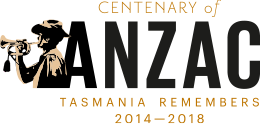Claremont Training Camp remembered
Walk of Remembrance
A series of visual displays are planned for the former World War One training camp at Claremont to form a Walk of Remembrance that will follow in the footsteps of Tasmanians soldiers who served.
The Rotary Club of Claremont has received a $5,000 Centenary of ANZAC grant to create the Walk of Remembrance which it hopes will bring to life the memory of the brave men and their achievements in both World War One and later life.
Panels will be placed at prominent locations on the former training grounds to showcase the efforts and importance of the locality. The panels will honour those who trained and fought overseas, and in some cases, made the ultimate sacrifice.
When thousands of troops enlisted in the First World War, a camp was immediately established at Brighton in southern Tasmania, but lack of water was a problem. After the first contingent of troops left in October 1914, the main training camp was moved to Triffetts Point, Claremont, on what is now substantially the Cadbury Estate, Cadbury Factory and Claremont Golf Club.
A good place to train troops
Logistically, Claremont was a good location for a training camp. It was close to the railway, near — but not too near –– the city of Hobart, and a port of embarkation.
Trenches and dugouts provided realistic training conditions and the camp housed up to 2200 men.
Military historian and Centenary of ANZAC Steering Committee member, Reg A. Watson, wrote in The City of Glenorchy’s Military Heritage that the Claremont Camp was very large.
“The ‘tent’ city as it was termed was a self-sufficient entity, with laundry, dental surgery, hairdressing salon, fruit shop, washing place and Post Office, beside other administration centres.”
After training at Claremont, the Tasmanian troops fought in all major battle fronts such as Gallipoli, France, Belgium and Palestine, and served with the Tasmanian 12th, 40th and 15th Battalions and 26th Battalion, a joint Tasmanian and Queensland Battalion.
Once War was declared against Germany in August 1914, the Australian Government offered 23 Light Horse Regiments from the Militia Volunteers. The Light Horse was seen as the national arm of Australian defence and young men, mostly from the country, flocked to join. Of this Brigade, the 3rd Regiment was recruited from Tasmania.
2014 is the anniversary of the establishment of the training camp at Claremont on what is now substantially Cadbury Estate, Cadbury Factory and the Claremont Golf Club. The Rotary Club of Claremont members are embarking on a project to provide visual displays in the general area of the previous camp.
Read about other successful Centenary of ANZAC grant projects.
- Image of AIF recruits training at Claremont Camp by JW Beattie and courtesy Australian War Memorial H16149.



